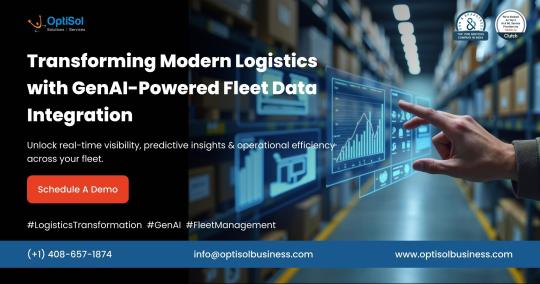Don't wanna be here? Send us removal request.
Text
Transforming Modern Logistics With GenAI- powered Fleet Data Integration

1 note
·
View note
Text
𝐄𝐧𝐚𝐛𝐥𝐢𝐧𝐠 𝐚 𝐆𝐥𝐨𝐛𝐚𝐥 𝐄𝐧𝐭𝐞𝐫𝐩𝐫𝐢𝐬𝐞 𝐭𝐨 𝐃𝐫𝐢𝐯𝐞 𝐅𝐚𝐬𝐭𝐞𝐫 𝐃𝐞𝐜𝐢𝐬𝐢𝐨𝐧𝐬 𝐰𝐢𝐭𝐡 𝐒𝐞𝐥𝐟‑𝐒𝐞𝐫𝐯𝐢𝐜𝐞𝐬 𝐀𝐧𝐚𝐥𝐲𝐭𝐢𝐜𝐬
In the era of data-driven decision-making, enterprises are rapidly moving toward tools that empower business users with real-time insights. One such success story is a U.S.-based global retail enterprise that turned to Opti Sol Business Solutions to eliminate their dependency on IT for data access and reporting.
The Challenge:
Despite having an Oracle-based data infrastructure across CRM, HRMS, inventory, and marketing, the client’s executives and managers faced a bottleneck: data retrieval required constant support from IT and BI teams. This delayed decisions and reduced operational agility.
The Solution: 𝐄𝐧𝐚𝐛𝐥𝐢𝐧𝐠 𝐚 𝐆𝐥𝐨𝐛𝐚𝐥 𝐄𝐧𝐭𝐞𝐫𝐩𝐫𝐢𝐬𝐞 𝐭𝐨 𝐃𝐫𝐢𝐯𝐞 𝐅𝐚𝐬𝐭𝐞𝐫 𝐃𝐞𝐜𝐢𝐬𝐢𝐨𝐧𝐬 𝐰𝐢𝐭𝐡 𝐒𝐞𝐥𝐟‑𝐒𝐞𝐫𝐯𝐢𝐜𝐞𝐬 𝐀𝐧𝐚𝐥𝐲𝐭𝐢𝐜𝐬
Opti Sol implemented a GenAI-powered Self-Service Analytics platform that integrated natural language querying, dynamic visual dashboards, and governed data access. Key steps included:
Re-engineering data into business-friendly star schemas
Enabling conversational queries (e.g., “Show me last quarter’s revenue by region”)
Automating visual reports and dashboards
Establishing secure, role-based access controls
Business Impact:
The results were transformative:
45% faster decision-making
40% reduction in IT & BI dependency
32% boost in cross-functional collaboration
Conclusion:
With this shift, 𝐄𝐧𝐚𝐛𝐥𝐢𝐧𝐠 𝐚 𝐆𝐥𝐨𝐛𝐚𝐥 𝐄𝐧𝐭𝐞𝐫𝐩𝐫𝐢𝐬𝐞 𝐭𝐨 𝐃𝐫𝐢𝐯𝐞 𝐅𝐚𝐬𝐭𝐞𝐫 𝐃𝐞𝐜𝐢𝐬𝐢𝐨𝐧𝐬 𝐰𝐢𝐭𝐡 𝐒𝐞𝐥𝐟‑𝐒𝐞𝐫𝐯𝐢𝐜𝐞𝐬 𝐀𝐧𝐚𝐥𝐲𝐭𝐢𝐜𝐬 the client empowered its teams to analyze and act on data instantly—without needing technical expertise. Self-service analytics helped the enterprise become more agile, data-driven, and efficient.

#SelfServiceAnalytics#EnterpriseAnalytics#GenAI#DataDrivenDecisions#BusinessIntelligence#DigitalTransformation#DataStrategy#RealTimeInsights#AnalyticsSolutions#DataEmpowerment#NoCodeAnalytics#SmartEnterprise#BITransformation#AIforBusiness#CXOInsights#OptiSolBusinessSolutions#DataVisualization#ITInnovation#EnterpriseTransformation#FasterDecisionMaking
1 note
·
View note
Text
Optimizing Logistics Operations with Data Integration

#LogisticsOptimization#DataIntegration#SmartLogistics#SupplyChainInnovation#FleetManagement#DigitalLogistics
0 notes
Text
Top 7 Reasons GenAI‑Powered Fleet Data Integration Is Essential for Modern Logistics
Introduction
Modern logistics demands speed, precision, and efficiency—something traditional, disconnected fleet systems struggle to deliver. Rising costs, stricter regulations, and high customer expectations are forcing logistics companies to evolve. GenAI-powered fleet data integration solves this by unifying critical data—vehicles, routes, drivers, and compliance—into one intelligent system. The result? Smarter decisions, reduced costs, and a clear competitive edge.
Top 7 Reasons GenAI‑Powered Fleet Data Integration Is Essential
1. Fuel and Maintenance Costs Are Eating Profits
When fleet systems can’t communicate, issues go undetected. For example, unaddressed engine diagnostics or inefficient routing can waste fuel and increase maintenance costs. GenAI-powered integration connects diagnostic data with routing intelligence, cutting maintenance costs by 23% and fuel consumption by 18% by identifying patterns that traditional tools miss.
2. Customers Won’t Tolerate Information Blackouts
Long, uncertain delivery time slots are now outdated. Today’s customers expect precise ETAs, real-time tracking, and instant notifications. By creating seamless data flow between your fleet and customer systems, GenAI enables Amazon-like delivery transparency and satisfaction.
3. Finding and Keeping Drivers Requires Better Technology
Driver shortage is a major challenge, and outdated tools are part of the problem. Drivers get frustrated with double data entry and multiple uncoordinated apps. Fleets using GenAI-powered integration provide a streamlined driver experience and report 27% higher retention rates than industry averages.
4. Safety Issues Multiply in Data Blind Spots
Safety risks increase when telematics, training records, and maintenance logs are stored in isolated systems. GenAI integration analyzes cross-platform data to flag high-risk drivers or vehicles, reducing preventable accidents by 35% and helping lower insurance premiums.
5. Route Optimization Only Works with Complete Data
GPS alone isn’t enough to ensure efficient deliveries. You need to factor in real-time traffic, delivery windows, driver hours, and vehicle limitations. GenAI-powered systems merge these data points to optimize routes, reduce miles driven by 12–15%, and increase on-time performance.
6. Regulators Are Getting Less Forgiving
From electronic logging devices (ELDs) to emissions mandates, compliance is getting stricter—and penalties are steeper. GenAI integration ensures compliance by automatically syncing driver logs, vehicle data, and documentation—reducing both errors and admin workload.
7. Competitors Are Already Pulling Ahead
In a competitive market, intelligence is an edge. Fleets with GenAI-powered integration gain operational visibility, quote smarter rates, and provide better customer experiences. Those still operating with disconnected systems risk falling behind faster-moving, data-driven competitors.
Conclusion
With rising costs and high expectations, Top 7 Reasons GenAI‑Powered Fleet Data Integration Is Essential is no longer optional. It delivers real-time insights, reduces expenses, ensures compliance, and enhances customer satisfaction. For modern logistics, it’s not just a tool—it’s a strategic necessity.

#GenAI#FleetManagement#LogisticsInnovation#AIinLogistics#FleetTechnology#DataDrivenLogistics#SmartFleet#LogisticsTransformation#AIIntegration#SupplyChainTech#PredictiveAnalytics#DigitalLogistics#FutureOfLogistics#FleetOptimization
0 notes
Text
GenAI-Driven Self-Service Analytics for Business Users
OptiSol’s GenAI-powered self-service analytics platform enables business users to gain instant insights without writing a single line of code. Ask questions in plain English and get real-time, visual responses powered by Snowflake. Designed for decision-makers and non-technical teams, this tool simplifies data access, enhances productivity, and empowers smarter decisions with ease

1 note
·
View note
Text

Enabling a Global Enterprise to Drive Faster Decisions with Self-Service Analytics
Discover how a global enterprise transformed its decision-making with AI-powered self-service analytics. By implementing a modern data solution, business users across departments now access real-time insights without relying on technical teams — leading to faster decisions, improved efficiency, and a truly data-driven culture.
Key Highlights: ✔️ Self-service dashboards for non-technical users ✔️ Real-time insights from complex data ✔️ Integration with Snowflake for secure access ✔️ Reduced IT dependency ✔️ Improved business agility
#SelfServiceAnalytics#EnterpriseAI#BusinessIntelligence#AIAnalytics#DataDriven#DigitalTransformation#BIPlatform#OptiSol
2 notes
·
View notes
Text
How Self-Service Analytics Empowered a Retail Enterprise to Make Data-Driven Decisions
In the age of digital transformation, data is often described as the new oil. But for many enterprises, data remains trapped in complex systems—untapped, underutilized, and inaccessible to the very teams that need it most.
This was the challenge faced by a U.S.-based retail enterprise that had heavily invested in Oracle-based systems across CRM, HRMS, marketing, and inventory. Despite the robust infrastructure, the business teams struggled to extract timely insights due to over-reliance on IT and disconnected data sources.
The Challenge
The organization encountered three major roadblocks:
Limited Access to Data: Business users couldn’t run their own reports or queries and were dependent on the IT team for data retrieval.
IT Bottlenecks: Report requests piled up, slowing the IT department and delaying decisions.
Siloed Information: Disparate systems meant fragmented insights, limiting visibility and strategic foresight.
The Solution: iBeam-Powered Self-Service Analytics
To solve this, OptiSol Business Solutions introduced a transformative Self-Service Analytics solution powered by its proprietary accelerator, iBeam. The key features included:
Star Schema Data Modeling Simplified and structured the data for easy access and exploration.
Natural Language Query Interface Enabled business users to ask data questions in everyday English—no SQL required.
Real-Time Dashboards Provided interactive visualizations that updated live, helping stakeholders make quick, informed decisions.
Seamless Oracle Integration Connected directly with the existing Oracle infrastructure, reducing disruption and maximizing previous investments.
The Business Impact
This initiative had a profound effect on the client’s operations:
Accelerated Decision-Making Teams could analyze and act on data independently, without waiting on IT.
Data Democratization Departmental silos were broken, allowing for cross-functional collaboration and insights.
Improved IT Efficiency The IT team shifted focus from routine reporting to strategic projects.
Agility in a Competitive Market Leadership gained the ability to respond to trends and challenges with data-backed strategies.
Conclusion
This case is a clear example of how Self-Service Analytics isn’t just a technology investment, it’s a business enabler. By empowering end users with intuitive access to data, companies can cultivate a truly data-driven culture.
At Opti Sol, we believe that when the right people have access to the right data at the right time, the possibilities for innovation and growth are endless.

#SelfServiceAnalytics#DataDriven#DigitalTransformation#BusinessIntelligence#EnterpriseData#OracleAnalytics#RetailTechnology#DataVisualization#iBeam#OptiSol#DataStrategy#AnalyticsTransformation#BI#EnterpriseSolutions#DataAccess
1 note
·
View note
Text
AI-Driven Self-Service Analytics: Unlocking Smarter Business Decisions
In today’s fast-paced digital world, businesses need to act on data faster than ever. Traditional analytics often require technical expertise and long turnaround times — making it hard for teams to get the insights they need when they need them. That’s where AI-driven self-service analytics comes in.
By integrating Generative AI (GenAI) with user-friendly dashboards, modern self-service analytics platforms allow employees across departments to explore data using natural language queries. For example, a sales manager can simply ask, “What were our top-selling products this month?” — and get instant, visual answers without coding or IT support.
Key Benefits:
Faster decisions: No more delays waiting for reports.
Data for all: Non-technical users can easily explore data.
Scalability: Handles complex, growing data sets.
Efficiency: Frees up IT teams for strategic work.
This shift enables businesses to build a truly data-driven culture, where decisions are backed by insights — not guesswork. Whether you're in retail, finance, or healthcare, AI-powered analytics is reshaping how organizations make smarter, faster decisions.

#AIAnalytics#SelfServiceAnalytics#GenerativeAI#BusinessIntelligence#DataDriven#EnterpriseAI#DataAnalytics#GenAI#DecisionIntelligence#AIinBusiness
0 notes
Text
Top 7 Reasons Enterprises Are Shifting to Self-Service Analytics
Introduction:
In today’s fast-paced digital world, enterprises are increasingly relying on data to make smarter business decisions. However, the traditional model of depending solely on IT and data science teams for reports is becoming outdated. That’s where Self-Service Analytics comes into play. It allows non-technical users to access, analyze, and visualize data without writing complex queries or waiting for IT support.
This shift isn’t just a trend—it’s a transformative move toward greater efficiency and agility. Here are the Top 7 reasons why enterprises are embracing self-service analytics.
1. Empowering Business Users
Self-service analytics tools like Power BI, Tableau, and Looker enable business users across departments to explore data independently. This autonomy leads to faster insights and improved decision-making.
2. Faster Decision-Making
Waiting for IT to generate reports can delay critical decisions. With real-time dashboards and drag-and-drop interfaces, self-service analytics enables quicker access to actionable insights.
3. Reduced Burden on IT Teams
By empowering end-users, IT teams can focus on strategic initiatives rather than spending hours fulfilling routine data requests. This improves operational efficiency across the board.
4. Increased Data Democratization
Self-service analytics promotes a data-driven culture where every team member can access and use data, breaking silos and fostering collaboration.
5. Customizable and Scalable Solutions
These tools offer scalable dashboards and custom visualizations tailored to departmental needs. Whether you're in sales, marketing, HR, or operations, insights are more personalized and relevant.
6. Improved Data Governance and Security
Contrary to the myth that self-service tools are less secure, modern platforms come with built-in governance, role-based access, and audit trails to maintain data integrity and compliance.
7. Cost-Efficiency and ROI
By reducing reliance on high-cost data teams for simple queries and reports, companies can cut operational costs and see a quicker return on their analytics investments.
Real-World Impact:
Companies adopting self-service analytics report improved KPIs, such as reduced decision-making time, higher customer satisfaction, and better cross-functional alignment. For example, marketing teams can run instant performance reports, while finance teams can monitor budget spend live—no IT delay involved.
Conclusion:
These are the Top 7 reasons why enterprises are embracing self-service analytics. The move toward self-service analytics is not just a shift in tools but a strategic evolution in how enterprises approach data. By putting the power of insights into the hands of decision-makers, businesses are becoming more agile, competitive, and responsive to market changes.

#SelfServiceAnalytics#BusinessIntelligence#DataDriven#AnalyticsTools#DataDemocratization#EnterpriseAnalytics#BITrends#DataEmpowerment#DigitalTransformation#RealTimeInsights#DataAnalytics#DecisionMaking#ModernBI#AnalyticsStrategy#Top7Reasons#EnterpriseIT#AgileBusiness#DataCulture#PowerBI#Tableau
0 notes
Text
Ai driven Self-Service Analytics for Modern Enterprises
In the fast-evolving digital era, data is the cornerstone of strategic decision-making. However, traditional analytics tools often create bottlenecks, requiring specialized skills and significant time investment. This is where Generative AI (GenAI) is stepping in to revolutionize self-service analytics, empowering modern enterprises to transform raw data into actionable insights with ease and speed.
What is Ai driven Self-Service Analytics for Modern Enterprises
Ai driven Self-Service Analytics allows business users to interact with data through natural language queries, eliminating the need for complex coding or deep technical knowledge. It democratizes data access, enabling everyone—from marketers and sales teams to executives—to derive insights and make data-driven decisions independently.
Key Benefits for Enterprises
Conversational Data Exploration
GenAI enables users to ask questions in plain English and receive instant, insightful visualizations. This dramatically simplifies data access and encourages broader usage across departments.
2. Accelerated Decision-Making
By automating pattern recognition and insight generation, GenAI reduces the time it takes to go from data to decision, increasing organizational agility.
3. Predictive and Prescriptive Insights
GenAI doesn’t just analyze historical data—it predicts future trends and suggests recommended actions, making it a valuable tool for strategic planning and risk management.
4. Enhanced Data Literacy
With intuitive interfaces and intelligent assistance, even non-technical users can confidently work with complex datasets, fostering a data-driven culture within the organization.
5. Seamless System Integration
These solutions integrate effortlessly with existing data warehouses and platforms like Snowflake, Oracle, and SQL Server, maintaining enterprise-grade security and governance.
Real-World Impact
Companies implementing GenAI-powered analytics are witnessing significant improvements in operational efficiency, customer experience, and innovation. Teams can identify growth opportunities faster, respond to market shifts proactively, and make informed decisions without waiting on IT or data teams.
Conclusion
Ai driven Self-Service Analytic is no longer a futuristic concept, it's a present-day necessity for enterprises aiming to stay competitive. By unlocking the full potential of data for every employee, organizations can accelerate digital transformation, improve productivity, and drive sustained growth.

#AI#Analytics#DataScience#BusinessIntelligence#DataAnalytics#SelfServiceAnalytics#AIDrivenAnalytics#GenAI#EnterpriseAI#PredictiveAnalytics#DataDemocratization#InsightDriven#DataForAll
0 notes
Text
Optimizing Logistics with Data Integration & Automation
In a rapidly evolving logistics landscape, companies are under constant pressure to enhance speed, accuracy, and customer experience. One U.S.-based logistics enterprise took a strategic leap forward by implementing advanced technologies to overcome operational roadblocks. The result? A smarter, faster, and more scalable logistics system.
Partnering with Opti Sol Business Solutions, the company focused on Optimizing logistics with data integration & automation, transforming legacy processes into streamlined, intelligent workflows.
Challenges Faced:
Disconnected systems for fleet, procurement, and fulfillment
Manual documentation slowing down operations
Limited visibility into real-time logistics data
High volume of delivery verification disputes
Digital Solutions Delivered:
Integrated Data Architecture: Using OptiSol’s iBEAM accelerators, the company unified its data sources for real-time access and decision-making.
AI-Powered Document Automation: Contracts and purchase orders were validated with intelligent document processing (IDP).
Computer Vision: Last-mile logistics were enhanced using vision-based delivery validation.
Conversational AI (elsAI): Fleet maintenance and procurement queries were automated for faster responses.
Measurable Outcomes:
🚚 42% reduction in procurement cycle times
📊 37% faster decision-making
📦 35% decrease in delivery-related disputes
This case proves that Optimizing logistics with data integration & automation is not just a trend—it’s a necessity for companies aiming to stay competitive and responsive in real time.

#Optimizinglogistics#DataIntegration#Automation#logistics Automation#SupplyChainTransformation#EnterpriseDataIntegration#AIInLogistics#OptiSolLogisticsCaseStudy
0 notes
Text
Top 5 Benefits of Data Integration in Logistics - Enterprise Data Unification
Introduction
In today’s complex supply chain environment, organizations must deal with data scattered across Transportation Management Systems (TMS), Warehouse Management Systems (WMS), ERP software, and spreadsheets. Without integration, this creates inefficiencies and blind spots.
In this article, we’ll explore the Top 5 Benefits of Data Integration in Logistics and how it can transform operational performance, efficiency, and decision-making.
1. Real-Time Visibility Across the Supply Chain
real-time visibility into operations. Integrated systems provide a holistic view of your fleet, inventory, warehouse operations, and delivery schedules. This visibility enables faster decisions and better control over logistics processes.
2. Quick Access to Actionable Insights
By eliminating data silos, integrated platforms deliver real-time data insights. Logistics managers can immediately access shipping statuses, inventory levels, and exception alerts.
3. Unified Metrics Across Teams
When different departments work with separate data sources, confusion and misalignment occur. Data integration ensures that all teams—from operations to finance—use the same KPIs and reports. This consistency boosts collaboration and performance tracking.
4. Smarter Forecasting with Predictive Analytics
Integrated historical and live data supports demand forecasting, route optimization, and inventory planning—leading to fewer stockouts, minimized costs, and better preparedness.
5. Cost Efficiency and Streamlined Processes
Integrated data exposes inefficiencies, redundancies, and bottlenecks. This clarity allows organizations to automate manual processes, reduce labor costs, and improve service levels—making cost optimization a major benefit of logistics data integration.
Conclusion
The Top 5 Benefits of Data Integration in Logistics include improved visibility, real-time analytics, better collaboration, smarter forecasting, and reduced costs. As logistics grows more complex, companies that adopt integrated data strategies gain a powerful competitive edge.

#Top5BenefitsOfDataIntegrationInLogistics#LogisticsTechnology#SupplyChainInnovation#DataIntegration#LogisticsSolutions#WarehouseManagement#TransportationManagement#PredictiveAnalytics#DigitalTransformation#SmartLogistics#BusinessEfficiency#SupplyChainVisibility#OptiSol
0 notes
Text
Enterprise Data Insights Using Self-Service Analytics
Introduction
In the era of digital transformation, organizations are increasingly focused on gaining Enterprise Data Insights Using Self-Service Analytics. Businesses generate enormous amounts of data every day, and the ability to transform that data into actionable insights is critical for informed decision-making. Self-service analytics tools, such as Microsoft Power BI, are empowering non-technical users to explore data, build custom reports, and make data-driven decisions—without relying entirely on IT teams.
Case Study: How OptiSol Enabled Enterprise Data Insights Using Self-Service Analytics
OptiSol Business Solutions implemented a powerful self-service analytics platform for a global logistics enterprise that was struggling with slow, manual reporting processes. The client needed a solution to extract meaningful insights from multiple data sources—quickly and securely.
Solution Highlights
Customized Dashboards – Developed role-based dashboards for operations, sales, and executive teams.
Data Integration – Integrated seamlessly with Azure Data Lake and SQL Server to centralize and manage data.
Automated Reports – Reduced manual workload by implementing scheduled, automated reports.
Role-Based Access Control – Ensured secure data access by implementing user-level permissions.
Mobile Access – Enabled decision-makers to access dashboards and reports anytime, anywhere.
Business Benefits
By enabling Enterprise Data Insights Using Self-Service Analytics, the solution delivered tangible improvements:
Better Decision-Making with real-time, interactive dashboard
Faster Reporting with automation reducing manual effort
Stronger Data Security with role-based access
User Empowerment for non-technical staff to generate their own insights
Conclusion
The ability to generate enterprise data insights using self-service analytics is transforming how businesses operate. OptiSol’s implementation helped the logistics client move from reactive to proactive decision-making by unlocking the full value of their enterprise data.
Whether it’s logistics, healthcare, or retail—self-service analytics platforms offer the scalability, flexibility, and control needed to thrive in a data-first world.

#EnterpriseDataInsights#SelfServiceAnalytics#PowerBI#DataAnalytics#BusinessIntelligence#DataVisualization#OptiSol#DigitalTransformation#EnterpriseSolutions
0 notes
Text
Top 5 Benefits of GenAI-powered Self-Service Analytics for Modern Enterprises
In the age of data-driven decision-making, enterprises are under constant pressure to access insights quickly and efficiently. Traditional analytics tools, while powerful, often require specialized skills and lengthy processes. Enter GenAI-Driven Analytics — a revolutionary advancement that is transforming how businesses approach self-service analytics.
Here are the Top 5 benefits of GenAI-powered self-service analytics for modern enterprises:
1. Natural Language Data Interaction
GenAI allows users to interact with data using simple, conversational language. This removes the need to understand complex query languages or dashboard configurations, making analytics accessible to non-technical users across the organization.
2. Faster Decision-Making
With GenAI, insights are delivered in real-time. Executives and managers can ask questions and get instant summaries, charts, or reports—significantly reducing turnaround time and enabling more agile business decisions.
3. Enhanced Productivity for Data Teams
By enabling self-service, GenAI reduces the burden on data analysts and IT teams. This allows technical teams to focus on high-priority, strategic projects rather than handling repetitive queries.
4. Democratization of Data
GenAI empowers every employee—regardless of their technical background—to explore and act on data. This fosters a data-driven culture and ensures better collaboration across departments.
5. Scalable and Cost-Efficient
Once implemented, GenAI solutions can scale across teams and business units. Enterprises save time and costs associated with training, manual reporting, and legacy BI tools.
Conclusion:
GenAI-Driven Analytics is not just a trend—it's a strategic enabler for modern enterprises. By simplifying access to insights, it helps organizations stay competitive, agile, and truly data-driven.
#GenAI#GenAIDrivenAnalytics#SelfServiceAnalytics#DataDrivenDecisions#BusinessIntelligence#EnterpriseAI#AIAnalytics#DigitalTransformation#DataDemocratization#RealTimeInsights#ModernEnterprises#AIPoweredSolutions#AnalyticsInnovation#OptiSolBusiness
0 notes
Text
Self-Service Analytics
Unlock the power of real-time, Self-Service Analytics with a solution designed to provide fast insights without relying on IT. Streamline your data processes, gain instant visibility, and make informed decisions quickly—empowering your team to take control and drive business growth
#SelfServiceAnalytics#BusinessIntelligence#DataVisualization#NoCode#OptiSol#BI#AnalyticsTools#DataDriven
0 notes
Text
Enterprise Data Unification & Automation: Transforming Business Intelligence
In today’s digital age, enterprises face a growing challenge: managing vast volumes of scattered data across multiple departments and systems. This fragmented approach often leads to inefficiencies, missed insights, and poor decision-making. That’s where Enterprise Data Unification and Automation becomes essential.
What is Enterprise Data Unification? Enterprise Data Unification is the process of consolidating all business data—structured, unstructured, and semi-structured—into one centralized platform. It breaks down silos between departments, ensuring seamless access to real-time, accurate information.
This unified approach helps organizations:
Gain a 360-degree view of business operations
Improve data accuracy and integrity
Enhance collaboration across departments
Make faster, smarter decisions
Why Pair It with Automation? Automation streamlines repetitive data processes such as extraction, cleansing, and integration. When combined with unification, it leads to a fully optimized data environment.
Key automation benefits include:
Reduced manual workload
Faster data processing
Fewer errors and inconsistencies
Real-time data updates for dynamic decision-making
Introducing OptiSol’s Enterprise Data Unification & Automation Solution OptiSol offers a robust, scalable solution designed to help organizations unify and automate their data ecosystem. With features like seamless integration, customizable dashboards, and AI-powered analytics, OptiSol empowers businesses to drive growth through data intelligence.
Use Cases:
Retail: Merge customer data, purchasing history, and inventory systems for targeted marketing
Healthcare: Unify patient records, lab results, and appointment schedules for better service
Finance: Integrate financial data to streamline compliance and reporting
Logistics: Automate tracking and supply chain data to enhance operational visibility
Conclusion: Enterprise Data Unification and Automation is no longer a luxury—it’s a necessity for businesses aiming to stay agile and competitive. By investing in the right solution, like the one offered by OptiSol, companies can unlock hidden value in their data and power next-gen decision-making.
#Enterprise Data#Data Automation#Data Unification#Business Intelligence#OptiSol#Digital Transformation#Data Integration#Smart Analytics
0 notes
Text
Enterprise Data Unification
Simplify your enterprise data challenges with OptiSol's powerful Data Unification & Automation Solution. Centralize, clean, and connect your data sources seamlessly to unlock real-time insights and make smarter business decisions. Explore how automation can elevate your data strategy!
#EnterpriseData#DataUnification#DataAutomation#BusinessIntelligence#DigitalTransformation#DataIntegration
0 notes